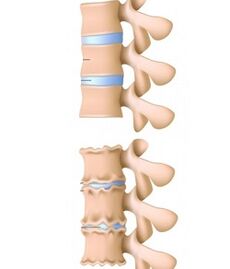
What are the causes of cervical osteochondrosis? What are the symptomsHow can you effectively treat osteochondrosis of the cervical spine at home?
Cervical osteochondrosis is one of the widespread diseases affecting more and more young people (25-40 years of age). The development of cervical osteochondrosis is facilitated by prolonged stay in the wrong, tense posture - for example, working on the computer during the day or the habit of supporting the telephone receiver with your shoulder.
It is often caused by prolonged exposure to vibration, e. g. B. when working with construction machinery or driving a car. Incorrect posture, uncomfortable bed, sedentary lifestyle, hereditary predisposition, and other factors can also lead to osteochondrosis of the cervix.
Cervical osteochondrosis and its causes
Cervical osteochondrosis is a degenerative-dystrophic lesion of the intervertebral disc in the cervical spine. It occurs against the background of metabolic disorders in the cervical spine, in which the structure of the intervertebral discs (special spacers between the vertebrae) and the vertebral bodies themselves change.
In terms of symptoms, cervical osteochondrosis is a little different from osteochondrosis of other parts. This is the most dangerous type of osteochondrosis as it often results in injury to the nerve root that extends from the spinal cord and disruption of the blood supply to the brain due to compression of the blood vessels. The reason is the peculiarities of the anatomical structure of the spine in the neck zone. One of the large arteries that supply the brain - the vertebral artery - runs precisely in the openings of the processes of the cervical vertebrae. Therefore, pathological changes in them - the proliferation of bone and fibrous tissue, the displacement of the vertebra - lead to a disruption of the normal functioning of this artery.
In addition, the structure of the spine is slightly different in the cervical spine - the vertebrae are closer together. Therefore, with any, even insignificant, pathological change in any of the vertebrae, the normal functioning of the entire section is disrupted - depression or dislocation of nerves and blood vessels, as well as more frequent compression of the spinal cord than with lumbar or thoracic osteochondrosis. As a result, with cervical osteochondrosis, significant functional disorders can be observed - a disruption of the sensitivity of the skin and muscles of the neck, face, hands, dizziness. There may be noises or ringing in the ears and head, persistent headaches, increased tiredness, blurred vision and hearing, inconsistencies in walking, and so on.
Symptoms of cervical osteochondrosis

Of the symptoms of cervical osteochondrosis, we note the following:
- Pain in the neck, back of the head, shoulder, or arm. In addition, weakness in the arm muscles, difficulty moving the head, and a crunch in the neck when turning or tilting the head to one side are often observed.
- Often there is a drawing pain in the left side of the chest that radiates to the left arm. There may be a burning sensation or pain between the shoulder blades.
- Cervical osteochondrosis causes recurring headaches, feelings of weakness, and increased tiredness. Usually the pain is painful in nature and is concentrated on the side and neck, as well as the back of the head. Patients often have difficulty moving their head, especially when it is rotating in different directions.
- Neck pain can radiate to the arm and extend from the shoulder to the hand, with numb fingers. In this case, patients sometimes complain of "itching" or "passage of electric current" along the arms and legs when they flex their necks.
- Cervical osteochondrosis can also cause hearing and vision problems, pain in the hands, dysfunction of the heart and lungs, dizziness, nausea, double vision, numbness of the face and tongue.
What is cervical osteochondrosis? What are the symptomsHow to treat cervical osteochondrosis
Treatment of cervical osteochondrosis
As a rule, cervical osteochondrosis begins in a mild form and does not initially cause the person any particular discomfort. Medical treatment at this stage is usually not required. It is just enough to avoid further complications, improve working conditions and revise the lifestyle in favor of a healthier one.
To prevent cervical osteochondrosis, lead an active lifestyle, do morning exercises, follow a low-calorie diet, get rid of bad habits, and avoid heavy lifting. Upright posture, correct posture when sitting and sleeping, and a comfortable bed are also important factors in prevention. Remedial gymnastics classes will also come in handy.
However, as you age, cervical osteochondrosis progresses and can progress into more severe forms. In this case, the treatment of cervical osteochondrosis is carried out according to conservative methods. Including: wearing special collars, physiotherapy, exercise therapy, massage. In more severe cases, the patient may need drug therapy - analgesics, anticonvulsants, nonsteroidal anti-inflammatory drugs (NSAIDs). Physiotherapy procedures are also prescribed (paraffin, medical electrophoresis, etc. ).
For the treatment of chronic osteochondrosis of the cervical spine, chondroprotectors and B vitamins (B6, B12) are shown. Medicines for external use are widely used - ointments, creams, gels containing NSAIDs, local irritants and stimulants for tissue regeneration.
Recently, a new drug has appeared in pharmacies that can provide serious help in the treatment of cervical osteochondrosis - a therapeutic anti-inflammatory analgesic.
Treatment of cervical osteochondrosis with a medicated plaster
In the therapeutic treatment of cervical osteochondrosis, various agents are used, such as NSAIDs, analgesics, antispasmodics. All of these funds are effective, but with prolonged use they can harm the body. Hence, it is very important to minimize side effects and improve the effectiveness of the treatment. This can be helped by a new generation drug - an anesthetic anti-inflammatory medical patch.
The healing patch is very effective, it allows you to relieve pain and inflammation, improve blood circulation in the affected area, and reduce the dose of pain relievers and anti-inflammatory drugs.
In the treatment of cervical osteochondrosis, a medical patch is applied to the troublesome area of the neck, avoiding the front, especially the area of the carotid arteries and lymph nodes. Treatment of 9 days or more is recommended. It is usually recommended to use the patch at noon in the morning, but it is possible to use it at night.
High efficiency, uniqueness of composition, long-term therapeutic effect, ease of use and affordable price make the medical patch a means of choice in the treatment of cervical osteochondrosis.
























